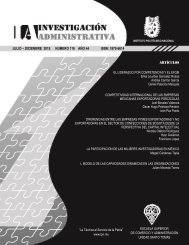Versión 3.0 previa a revision final de autores
Create successful ePaper yourself
Turn your PDF publications into a flip-book with our unique Google optimized e-Paper software.
61<br />
Otálora, R. N.; Gutiérrez, H.; López, F.<br />
Es un sector <strong>de</strong> difícil acceso para este tipo <strong>de</strong> estudios,<br />
don<strong>de</strong> los empresarios <strong>de</strong>muestran poco interés, son muy<br />
reservados al momento <strong>de</strong> dar información, Lo que generó<br />
<strong>de</strong>sgaste y atrasos en el trabajo <strong>de</strong> campo.<br />
Este artículo pue<strong>de</strong> ser insumo para la política empresarial<br />
<strong>de</strong>l sector <strong>de</strong> confecciones en la capital <strong>de</strong>l país y ser<br />
revisado en el tiempo para comparar la evolución <strong>de</strong>l<br />
capital intelectual <strong>de</strong> las pymes <strong>de</strong> confecciones <strong>de</strong><br />
Bogota. D.C .<br />
REFERENCIAS<br />
Barton, D., (1995). Wellsprings of knowledge: building un<br />
sustaining the sources of innovation. Boston, EEUU:<br />
Harvard Business School Press.<br />
Badaracco, J. L., (1991). The Knowledge Link. How the<br />
firm compete trough strategic alliances. Boston, EEUU:<br />
Harvard Business School Press.<br />
Beazley, H., Boenisch, J., & Har<strong>de</strong>n, D., (2002). La<br />
continuidad <strong>de</strong>l conocimiento en las Organizaciones.<br />
Bogotá D.C., Colombia: Norma.<br />
Bontis, N. (1998). Intellectual Capital: An Exploratory<br />
Study that Develops Measures and Mo<strong>de</strong>l. Management<br />
Decision, 36(2), 63-76.<br />
Bontis, N. (2002). National intellectual capital in<strong>de</strong>x:<br />
intellectual capital <strong>de</strong>velopment in the Arab region.<br />
Ontario, Canada: Institute for Intellectual Capital<br />
Research.<br />
Bradley, K. (1997). Intellectual capital and the new wealth<br />
of nations. Business Strategic Review, 8(1), 53-62.<br />
Brooking, A. (1996). Intellectual Capital. Core Asset for the<br />
Third Millennium Enterprise. International Thomson<br />
Business Press, 97-113.<br />
Bueno, E. (1998). El capital intangible como clave<br />
estratégica en la competencia actual, Boletín <strong>de</strong> Estudios<br />
Económicos, 53, 207 -229.<br />
Cetisme (2002). Inteligencia económica y tecnológica.<br />
Guía para principiantes y profesionales. Boston. EEUU:<br />
Harvard Business School Press.<br />
Collis, D. & Montgomery, C. (1995). Competing on<br />
Resources: Strategy in the 1990s, Harvard Business<br />
Review, 73, 118-128.<br />
DIFERENCIAS ENTRE LAS EMPRESAS PYMES<br />
EXPORTADORAS Y NO EXPORTADORAS EN EL SECTOR DE<br />
CONFECCIONES DE BOGOTÁ DESDE LA PERSPECTIVA DEL<br />
CAPITAL INTELECTUAL<br />
Davenport & Prusak. (2001). Conocimiento en Acción,<br />
Cómo las organizaciones manejan lo que saben. México<br />
D.F. México: Prentice Hall.<br />
Drucker, P. (1959). Landmarks of Tomorrow. New York.<br />
EEUU: Harper.<br />
Drucker P. (1969).. The Age of Discontinuity; Gui<strong>de</strong>lines to<br />
Our changing Society. New York. EEUU: Harper and Row.<br />
Drucker, P. (1994). Post-Capitalist Society. New York.<br />
EEUU: Harper Business.<br />
Edvinsson, L. & Sullivan, P. (1996). Developing a mo<strong>de</strong>l<br />
for managing intellectual capital, European Management<br />
Journal, 14, (4), 356-364.<br />
Edvinsson, L., & Malone, M. (1999). El Capital Intelectual.<br />
Barcelona. España: Gestión 2000.<br />
Escandón Barbosa, D. M. & Hurtado Ayala, A. (2014). Los<br />
<strong>de</strong>terminantes <strong>de</strong> la orientación exportadora y los<br />
resultados en las pymes exportadoras en Colombia.<br />
Estudios Gerenciales, 30,(133), 430-440.<br />
Euroforum (1998). Medición <strong>de</strong>l Capital Intelectual. Mo<strong>de</strong>lo<br />
Intelect. Madrid. España: Ed. I.U.<br />
Galtieri, A., & Mantiñan, M. J. (2001). La gestión <strong>de</strong>l<br />
conocimiento como principal fuente <strong>de</strong> valor económico.<br />
Buenos Aires, Argentina: Universidad <strong>de</strong>l CEMA.<br />
Garcia Á & Teijero M. (2011). Structural Capital<br />
Management: A Gui<strong>de</strong> for Indicators. International Journal<br />
of Management and Information Systems. 15,(3) p. 41-60.<br />
The Clute Institute.<br />
Geenhuizen, M. (2008): Value-ad<strong>de</strong>d partnering and<br />
innovation in a changing world. Purdue University Press.<br />
González, M. (2006). El negocio es el conocimiento.<br />
Malaga. España:Ediciones Díaz <strong>de</strong> Santos.<br />
Gibbert, M., Leibold, M. & Voelpe, S. (2001). Rejuvenating<br />
corporate intellectual capital by coopting customer<br />
competence, Journal of Intellectual Capital, 2, (2), 109-<br />
126.<br />
Grant, R.(1996). Prospering in dynamically-com-petitive<br />
environments: Organizational capability as knowledge<br />
integration, Organization Science, 7, 375-387.<br />
#116 / Año 44 INVESTIGACIÓN ADMINISTRATIVA AÑO: 44 NÚM. 116 ISSN: 1870-6614



